
In this lesson, we’ll help you hone your critical reading skills to crack the most challenging of difficult text. We’ll also build on your mastery of the 4-Step Basic Approach by teaching you advanced POE (Process of Elimination) strategies.
By now, your use of the 4-Step Basic Approach and your personal order of difficulty (POOD) of both passages and questions should make you feel more confident on the Reading Test. But you also may still be struggling with time and feel that you just can’t work fast enough to get to enough questions.
In Chapter 20, we addressed time management skills. Critical reading skills and time management skills are entwined on the ACT, and it’s likely that when you struggle with time, it’s less because you don’t read fast enough and more that you can’t read and understand fast enough. You probably waste a lot of time when you read and reread the window of text, or even the entire passage, trying to figure out what it’s saying. When you’re stuck on a question, you likely reread several times the window of text. You may have even eliminated two answers, but when you’re still not sure what the correct answer is, what do you do? You read the window yet again, desperate to figure out the meaning and and correct answer.
We’ve all been there. Part of what makes standardized tests so evil is how they encourage us to listen to our worst instincts. You can’t treat the Reading Test as you would a school assignment, and you can’t fall prey to your own panicked responses. You have to develop both strategies and skills specific to this test.
The key to developing better reading skills is to learn to think better, which means to think critically. Getting lost in even a small window of text that makes no sense is like getting lost on unfamiliar roads. You wouldn’t stare down at the yellow line, would you? Instead you’d look around, looking for landmarks and road signs, trying to figure out where you are and where the road is going.
When you’re lost in a tough section of text, use topic sentences and transitions as your landmarks and road signs. Use the topic sentences to identify what the main point of the paragraph is. Look for transitions to see whether points are on the same or different sides from each other. Transition words are like great road signs. They show you the route, direct you to a detour, and get you back on the path of the main idea.
Think of how you write papers for school. A good topic sentence clarifies the main subject of the paragraph, and it may even provide the author’s main point on the subject. The rest of the paragraph will be details or examples that support that point, and it may also include a more explicit statement of the main point. If you don’t understand the details, focus on the main point. Examples and details usually come right before or right after the main point. But, if you don’t understand the main point, read the sentence before or after to see if the details explain it for you.
Let’s see how this works. Read the following topic sentence.
Most people define domesticated species from a typically anthropocentric context.
What’s going to come next in the paragraph? The author could provide examples of domesticated species under this definition, and thereby make clearer what she means by traditionally anthropocentric context. The author could explain why people use such a definition, or the author could state that most people are in fact wrong and there is a better definition to be had. You would be safe anticipating any of those outcomes, but the anticipation is the key. Don’t sit back and wait to see where the road is going. Lean forward and look for the fork in the road or the detour sign telling you to turn around. In other words, look for transitions.
The first word or phrase after the topic sentence can tell you what direction you’re heading.
Let’s look at some choices for our domesticated species sentence.
If the next words were For example, what does that tell you is coming next? Examples of the species and how they’ve been defined.
If the next words were In other words, what does that tell you is coming next? A restatement, most likely a clearer version of the author’s point.
If the next word were However, what does that tell you is coming next? A contradiction to this belief, possibly one the author herself agrees with.
Transitions play a key role in critical thinking. Look for transitions to announce additional points, contradictory points, cause and effect relationships, examples, or conclusions. Here are just a few common transitions.
Contradictory Points
Although
But
Even though
However
Nevertheless
On the other hand
Rather
Yet
Cause and Effect Relationships
Because
Since
So
Examples
For example
For instance
In particular
Such as
Conclusions
Consequently
In other words
That is
Therefore
Thus
Consider the two versions of the same sentence below, and note how changing the transition word affects the meaning.
Pollan has a deep grasp of and appreciation for the principles of evolution and botany, yet he tells his stories in an entertaining and easily understandable manner.
Pollan has a deep grasp of and appreciation for the principles of evolution and botany, and he tells his stories in an entertaining and easily understandable manner.
In the first version, the use of yet implies that there is a difference between principles of evolution and botany and writing in an entertaining and easily understandable manner. Yet implies that the author would not necessarily expect a book on evolution and botany to be either entertaining or easily understandable.
In the second version, the author supplies two facts about Pollan’s writing. There is nothing to infer about expectations of how the topic may be addressed. But even in the second version, there is something to infer. Note the modifiers deep, entertaining, and easily understandable. What do you know about the passage author? She approves of Pollan’s intellect and writing style.
Modifiers are the key to reading critically. Facts in a sentence provide information, but authors use modifiers to make a point with the facts.
Nouns and verbs reliably give you the facts in a statement, but they don’t necessarily provide the author’s point.
Look at the adverbs in the previous sentence and see how they helped shape the point: Reliably means you can infer that nouns and verbs almost always give facts. Necessarily modifies the verb phrase don’t provide. Without it, you could infer that nouns and verbs never give you the point. Adjectives and adverbs are just as useful as transitions, conveying the author’s opinion on what would otherwise be a statement of fact.
Consider the first topic sentence again.
Most people define domesticated species from a typically anthropocentric context.
How does the adverb typically affect anthropocentric context? The author implies that this should be expected. What does the choice of using most people imply? At the very least, some other people think differently, and it’s fair to presume the author is one of them. After all, if she agreed with this definition, wouldn’t she have just written a sentence providing this fact?
Domesticated species are defined from an anthropocentric context.
Without the modifiers, this sentence is a neutral statement of facts. The author’s deliberate choices of most people and typically allow us to infer her opinion on this stance and anticipate her own viewpoint to come.
Transitions and modifiers do not have a monopoly on conveying meaning and connections. Certain pronouns, used alone or as a modifier when paired with a noun or other modifiers, provide clear maps from one idea to another. Consider the following topic sentence
This problem of monoculture is not unique to the potato; a similar situation is described in the case of the apple.
This problem of monoculture directly identifies the topic of the prior paragraph, and the author characterizes the topic as a problem. Moreover, the phrase this problem of monoculture applies to the similar situation of the apple. The topic sentence allows us to infer that the rest of the paragraph will discuss how this problem of monoculture applies to the apple. Furthermore, the use of the pronoun this in front of the noun makes clear that monoculture was discussed and perhaps defined in the preceding paragraph.
The pronouns another, it, this, that, and such can be very useful road signs. These pronouns indicate that the subject has been discussed previously. Consider the following examples and what you can infer.
Such a technique has its advantages.
What’s the technique? It must have been explained in the preceding sentence. The following sentences will show its benefits.
It’s tempting, but it’s wrong.
It was explained in the preceding sentence, likely in a very positive manner (it’s “tempting”). But, the next sentence will explain why it is wrong.
When you’re struggling to make sense of a window of confusing text, look for transitions and modifiers to help you determine the main point. You may be in the thick of a body paragraph with the topic sentence in the rearview mirror, or the topic sentence fails to illuminate the main point of the paragraph. Instead of focusing on every single word, use the transitions, modifiers, and pronouns to get the general direction of points and the connections between them.
Let’s look at a tough paragraph and see how this works.

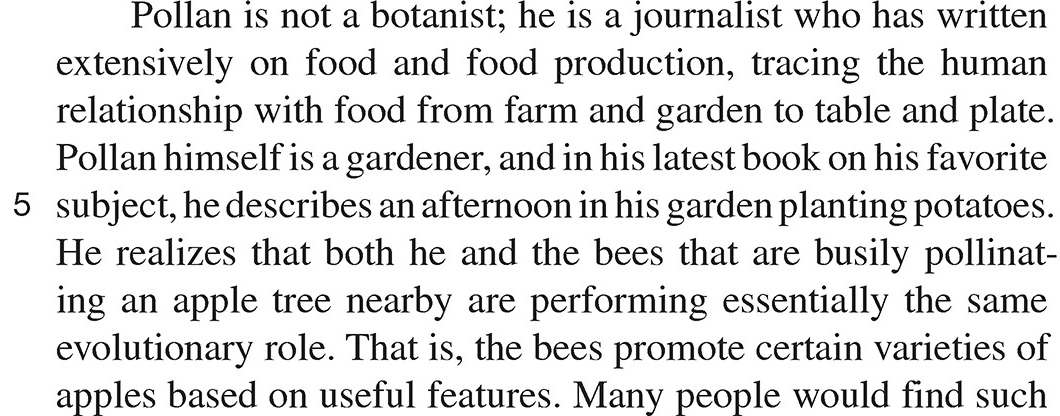

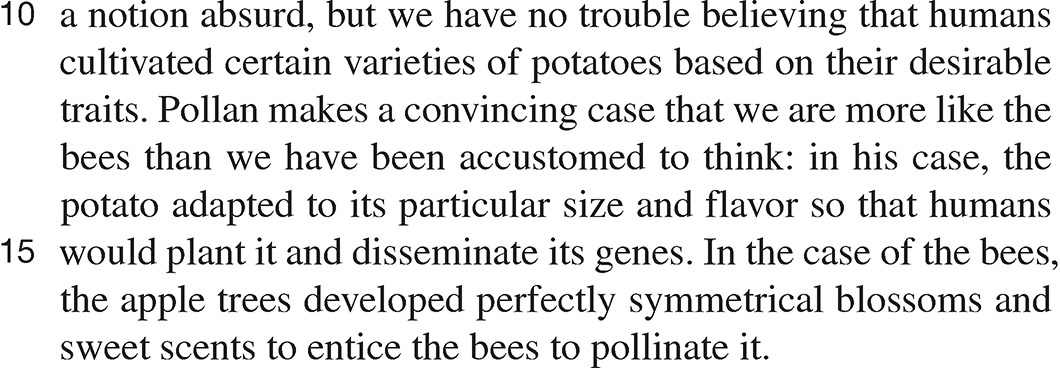

You may have struggled to understand the middle part of the paragraph and even opted to reread the whole paragraph, but a second time through probably still failed to clarify the author’s meaning
Focus on key modifiers, transitions, and pronouns. Same indicates a comparison between humans and bees, while the adverb essentially softens the similarity a bit. The transition that is leads into a restatement of the point. Such a notion about bees that we would find absurd is the claim that they promoted certain apples trees. The transition but leads into our having no trouble having the same notion about humans. The similarity between bees and humans is reinforced in the next sentence, we are more like the bees. Moreover, this sentence includes the author’s blessing: she calls Pollan’s case convincing. The parallel structure of in his case and in the case of the bees reasserts the similarity and in fact introduces specific examples of that same evolutionary role. The potato used humans. The apple trees used bees.

Critical thinking also extends to knowing more about the test writers themselves. You may find the passages dry and boring, but the folks at ACT would not agree with you. They have gone out of their way to select passages whose topics they find interesting and worthy of being read. They choose authors whose work they respect.
Thus, when it comes time to writing questions and correct answers, the ACT test writers will not make these chosen authors look bad by putting rude, silly, or offensive words in their mouths. The topics may include some challenging facts and ideas, but they are unlikely to be divisive or controversial. In the nonfiction passages, the authors may be critical or supportive of their subject, but they will state their opinions professionally and respectfully. Correct answers, therefore, must use the same level of diplomacy and respect to paraphrase the authors’ ideas.
• Topics are interesting and worthy.
• Authors are professional and respectful.
• Correct answers are not rude, silly, or offensive
Use this knowledge to eliminate at least one wrong answer below. If you’ve retained the brief information we’ve gleaned so far about the passage and what the author thinks of Michael Pollan, you may be able to eliminate one more or identify the correct answer. If not, stay tuned to the end of the lesson when the answer will be provided.

31. Which of the following best describes how the passage’s author describes Pollan?
A. A well-intentioned environmentalist willing to challenge the accepted practices of industrial food production.
B. A trained botanist attempting to replace the practice of monoculture with genetically modified foods.
C. A knowledgeable journalist able to use his story-selling skills to promote the importance of biodiversity.
D. A cynical author willing to shock readers in efforts to promote his book.
Here’s How to Crack It
Choice (D) is out. It’s offensive both to Michael Pollan and the passage’s author if it’s not true. On the extreme likelihood that the passage actually did discuss such an author, the correct answer would paraphrase it in a more tactful way. Choice (B) is also out. The paragraph cited for the Translation exercise stated the opposite. See the last section of this lesson for confirmation of the correct answer.

In an ideal situation, you would read a question, read the window of text looking for your answer, and then work through the answer choices to find for the best match, using POE to get rid of those that don’t.
But situations are seldom ideal on the Reading Test. When you don’t quite understand the window and therefore have no clue about the answer, go straight to working the answers. You can reread your window to spot transitions and modifiers, in conjunction with working the answers.
If you worked for ACT, you’d have to sit in a cubicle all day writing test questions. The easy part of the job is writing the correct answer (in respectful language, of course). You may even know the correct answer before you write the question. The harder part is coming up with three wrong answers. If you didn’t write great wrong answers, everyone would get a 36. So you have to come up with temptingly wrong answers.
Let’s take a look at some ways to make wrong answers.
Read the following question, correct answer, and text. We don’t care about the right answer in this exercise, so you can read it before you read the window.
35. The main point of the fourth paragraph (lines 1-45) is that:
A. some species may play a role in their domestication by developing traits that make them useful to humans.
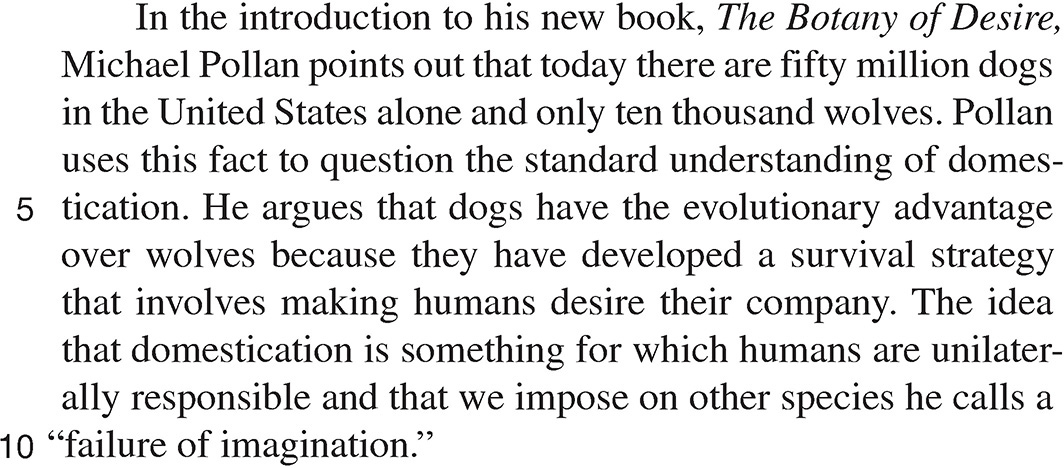

Our goal here is to examine why the three wrong answers are wrong.
B. humans developed an evolutionary strategy by making themselves desirable to dogs.
Look carefully at lines 6-7. Choice (B) took tempting words out of the passage and garbled them. The passage does not support this answer.
C. the evolutionary strategy of dogs has been more successful than that of wolves.
Lines 2-3 indicate that there are many more dogs than wolves, so you could infer that the dogs have developed a more successful strategy. But choice (C) is incorrect because the example of dogs is used to support the main point but is not itself the main point of the paragraph.
D. bees developed an evolutionary strategy dependent on the desirable traits of apples trees.
Bees and apple trees are not mentioned in this window and have instead been taken from a different window. Any choice that references facts or points from different windows is wrong.
Answers can be wrong because they don’t match what the passage says, because they answer the wrong question, or because they’re not even found in the right window. But no matter how tempting or obvious wrong answers are, they are all easier to understand than five to 10 lines of text from the passage, simply because they’re shorter. So when you’re stuck on tough questions that reference tough windows, rely on the answers and POE.
Instead of rereading the window to try to understand it, read the answer choices for their meaning. Then see if you can match that meaning back to part of the passage.
• Look for lead words or phrases in the answer choices.
• Determine whether the words or meaning match words or meaning in the window.
• Use POE to cross off choices that don’t match what’s in the window.
Let’s see how this works. Read the following question and window.
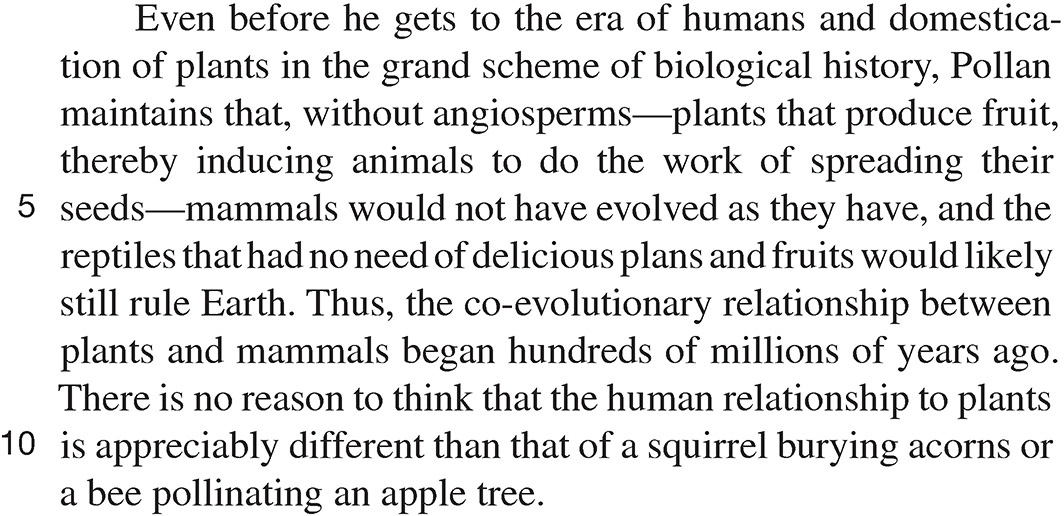

37. It can reasonably be inferred that the author provides the example of angiosperms (line 3) in order to:
Take the answer choices one at a time. In each choice, we’ve identified a lead word or phrase in the answer by making it bold. Can you match these words, or a paraphrased meaning of them, in the window of text?
A. argue that mammals developed traits more useful to plants than to reptiles.
The paragraph suggests that mammals were more useful to plants than were most reptiles, but it does not mention specific traits developed by mammals, and it does not discuss at all the relationship between mammals and reptiles.
B. reveal what traits made reptiles lose their dominance to mammals.
Likely still rule Earth is a good paraphrase of lose their dominance and that had no need of delicious plants and fruits could be the trait, or lack thereof, that disadvantaged reptiles. But this doesn’t give us a reason for including the example of angiosperms.
C. explain why dinosaurs became extinct.
The passage never mentions dinosaurs, so choice (C) can’t be right.
D. illustrate that the evolution of mammals depended on useful traits developed by plants.
The ability of angiosperms to produce fruit and get mammals to spread their seeds is a useful trait. Moreover, depended on is a good paraphrase of co-evolutionary relationship between plants and mammals. Choice (D) is the correct answer.
Try the next two examples. Choose your own words or phrases out of each answer to work backwards with. Does the answer match the passage?

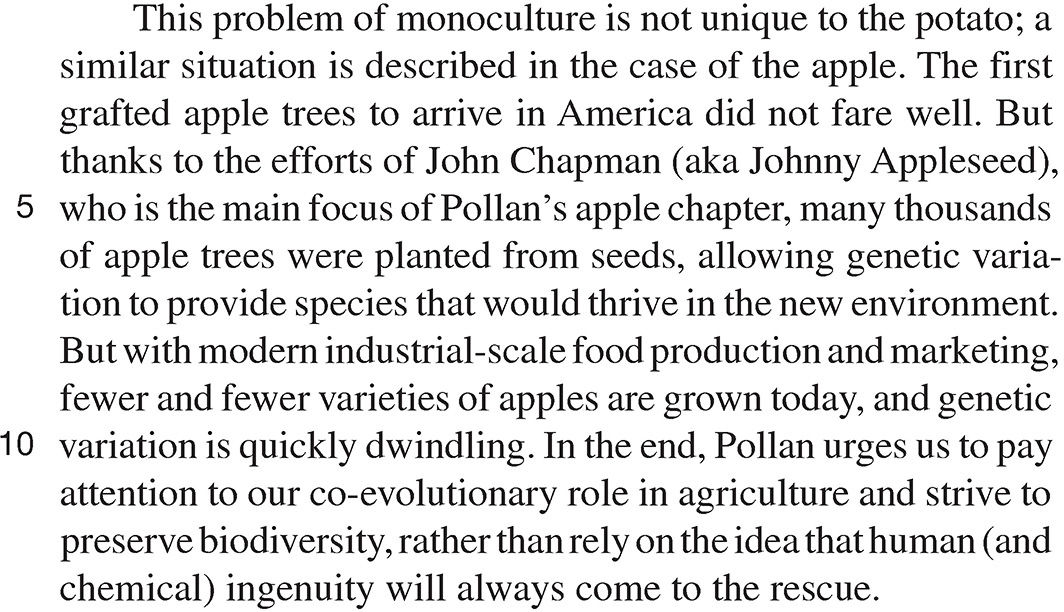

32. How does the passage’s author characterize the genetic variation of apples within the context of modern food production?
F. Threatened, to the point that several new varieties of apples planted today fail to thrive.
G. Declining, to the point that relatively few varieties are planted.
H. Declining, in that varieties derived from genetically modified seeds will replace the varieties descended from the seeds sown by Johnny Appleseed.
J. Threatened, in that several varieties of apples could soon be extinct.
33. Based on the passage, Pollan would most likely say that relying on human ingenuity is more a matter of:
A. being practical than of being naïve.
B. dismissing scientific facts than of learning from evolutionary history.
C. hoping for a solution to a problem than addressing the causes.
D. accepting hysteria than of remaining optimistic.
Here’s How to Crack Questions 32 and 33
For Question 32, the four answer choices all begin with a word that is a good paraphrase of dwindling. Fail to thrive in choice (F) misuses thrive, used to describe the trees grown from Johnny Appleseed. Few are planted in choice (G) is accurately placed in the paragraph and confirms choice (G) as the correct answer. Genetically modified seeds in choice (H) are not mentioned in the paragraph. Extinct in choice (J) cannot be supported by the passage.
For Question 33, practical and naïve in choice (A) may be possibilities, but they are in the wrong order. Human ingenuity is what Pollan discourages, thus naïve can’t match what he is encouraging. Evolutionary history in choice (B) could refer to our co-evolutionary role in agriculture but dismissing scientific facts is almost opposite to (chemical) ingenuity. Hoping for a solution in choice (C) matches well come to the rescue, and choice (C) is the correct answer. In choice (D), remaining optimistic is in the wrong place, a better paraphrase of what Pollan discourages rather than what he encourages.

Try using all of your critical reading skills on the next question.

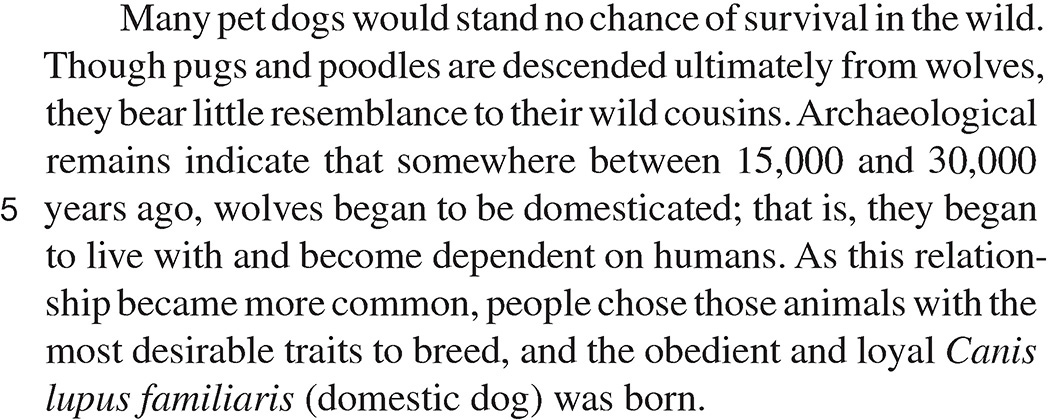

36. The main purpose of the first paragraph is to:
F. provide an example to introduce a concept that the rest of the passage will examine.
G. list the desirable traits that made humans domesticate dogs.
H. pose a theory that the rest of the passage will disprove.
J. explain how the process of domestication benefits biodiversity.
Here’s How to Crack It
The correct answer is choice (F). Dogs and wolves are an example of the concept of domestication, which is examined in the rest of the passage. Choice (G) is incorrect because the paragraph does not list the desirable traits. Choice (H) is tempting because the rest of the passage discusses Pollan’s point that dogs played some role in their domestication (see Question 35), but disprove is too strong. Choice (J) is incorrect because the paragraph does not explain anything, much less address biodiversity.

Question 36 above was easier to answer because of the knowledge gained from working the prior questions. No matter how well you may read a passage, you learn the main points better as you work the questions. The questions, after all, all come from the same passage and it only makes sense that they should agree with one another.
Take another look at Question 31, now paired with another question.

31.Which of the following best describes how the passage’s author describes Pollan?
A. A well-intentioned environmentalist willing to challenge the accepted practices of industrial food production.
B. A trained botanist attempting to replace the practice of monoculture with genetically modified foods.
C. A knowledgeable journalist able to use his story-selling skills to promote the importance of biodiversity.
D. A cynical author willing to shock readers in efforts to promote his book.
39. As a piece of writing, Pollan’s book is judged by the author to be:
A. inscrutable to all but trained experts in the field of botany.
B. revolutionary in its challenge of traditional understandings of domestication.
C. simplistic in an effort to attract gardeners and casual readers.
D. accessible and enjoyable in its mixture of anecdote and history.
Here’s How to Crack Questions 31 and 39
From several questions and selections of text, we have proof that the author approves of Pollan. One selection of text explicitly gave praise to his writing skills.
Pollan has a deep grasp of and appreciation for the principles of evolution and botany, yet he tells his stories in an entertaining and easily understandable manner.
This is the proof for choice (C) in Question 31 and choice (D) in Question 39. If you chose choice (A) for Question 31, the selection of (D) for Question 39 should make you change your answer. Keep your radar up as you make your way through the questions. Make sure your answers agree, and look for the golden thread.

Place yourself again in the cubicle of an ACT test writer. When you determine which details to test in a question, you would likely choose the important ones, those that support the main point. Thus the main idea runs throughout the correct answers of at least a few of the specific questions, like a golden thread that ties the questions together.

34. It can reasonably be inferred from the passage that by titling his book Botany of Desire, Pollan was trying to suggest that plants:
F. have the same feelings as mammals.
G. played some role in their own domestication.
H. have been cultivated as part of natural selection.
J. are dependent on humans for their evolution.
Here’s How to Crack It
Look at the answers to Questions 35 and 37. These answers identify choice (G) as the correct answer for Question 34. The paragraph we used in the translation exercise provides the proof from the passage for choice (G), but so too do the answers to the other questions, and in a more concise fashion.
